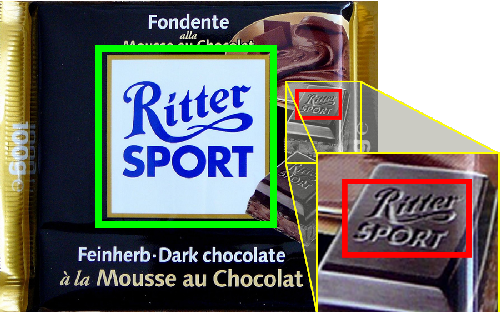In today’s digital era, logo detection, and recognition have become crucial for various applications such as brand monitoring, augmented reality, and image retrieval. Logo detection involves identifying the presence of a specific logo in an image or video, while logo recognition aims to classify and identify the logo accurately. In recent years, synthetic images have emerged as a valuable resource for training logo detection and recognition algorithms. This article explores the significance of logo detection and recognition with synthetic images, the challenges involved, and the role of synthetic images in improving these techniques.
Logo Detection And Recognition With Synthetic Images

Synthetic images have gained significant attention in recent years for training and improving logo detection and recognition models. Synthetic images are computer-generated images that can mimic real-world scenarios while providing full control over the logo’s appearance, position, and background. By generating a diverse set of synthetic images, researchers and developers can enhance the performance and generalization capabilities of logo detection and recognition algorithms.
Advantages of Using Logo Detection And Recognition With Synthetic Images
The use of synthetic images offers several advantages in the context of logo detection and recognition. Firstly, synthetic images provide a controlled environment for training, allowing researchers to generate datasets with a large number of annotated logos. This abundance of data helps improve the accuracy and robustness of logo detection and recognition algorithms. Furthermore, synthetic images enable the creation of challenging scenarios, such as occlusions, variations in lighting conditions, and different camera angles, which can enhance the algorithm’s resilience to real-world complexities.
What is Logo Detection and Recognition?
Logo detection is the process of locating and identifying logos within an image or video. It involves analyzing the visual features and patterns associated with a particular logo to determine its presence. On the other hand, logo recognition focuses on the classification and identification of logos once they are detected. It aims to assign a specific logo to its corresponding brand or organization.
Challenges in Logo Detection and Recognition
Logo detection and recognition present several challenges due to variations in logo design, scale, orientation, occlusions, and image quality. Logos can appear in different shapes, colors, and sizes, making their detection and recognition difficult. Moreover, real-world images often contain complex backgrounds, noise, and occlusions, which further complicate the process. Developing robust algorithms that can handle these challenges is crucial for achieving accurate logo detection and recognition.
Techniques for Logo Detection and Recognition

Logo detection and recognition employ various techniques, including deep learning approaches, feature-based approaches, and hybrid methods.
Deep Learning Approaches
- Deep learning techniques, particularly convolutional neural networks (CNNs), have shown remarkable success in logo detection and recognition tasks. CNNs can automatically learn relevant features from images and effectively classify logos. Transfer learning, where pre-trained CNN models are fine-tuned on logo datasets, has also proven to be effective in limited-data scenarios.
Feature-Based Approaches
- Feature-based approaches rely on handcrafted features such as SIFT (Scale-Invariant Feature Transform) or HOG (Histogram of Oriented Gradients). These methods extract discriminative features from images and employ classifiers like support vector machines (SVMs) or random forests for logo recognition. Feature-based approaches can be computationally efficient and suitable for scenarios with limited training data.
Hybrid Approaches
- Hybrid approaches combine deep learning and feature-based methods to leverage their respective strengths. These approaches utilize deep learning models to extract high-level features and then combine them with handcrafted features for improved performance in logo detection and recognition tasks.
Evaluation Metrics for Logo Recognition
- To assess the performance of logo detection and recognition algorithms, several evaluation metrics are used. Common metrics include precision, recall, F1 score, and mean average precision (mAP). Precision measures the ratio of correctly detected logos to the total number of detected logos, while recall calculates the ratio of correctly detected logos to the total number of actual logos present.
Applications of Logo Detection
Logo detection and recognition have various applications across different industries. In the marketing field, these techniques are employed for brand monitoring, tracking logo visibility on social media platforms, and analyzing advertisement effectiveness. In augmented reality applications, logo detection and recognition enable the seamless integration of virtual objects into real-world environments.
Future Trends in Logo Detection and Recognition
As technology advances, several future trends are expected in the field of logo detection and recognition. One area of development is the integration of logo detection and recognition with video analysis, enabling real-time logo tracking in videos. Additionally, the use of generative adversarial networks (GANs) for generating more realistic synthetic images holds promise for improving the robustness of logo detection and recognition algorithms.
FAQs
What is the difference between logo detection and logo recognition?
- Logo detection involves locating and identifying logos within an image or video, while logo recognition focuses on classifying and identifying specific logos.
How are synthetic images beneficial for logo detection and recognition?
- Synthetic images provide a controlled environment for training, allowing the generation of diverse datasets to improve the accuracy and robustness of logo detection and recognition algorithms.
Which techniques are commonly used for logo detection and recognition?
- Deep learning approaches, feature-based approaches, and hybrid methods are commonly used for logo detection and recognition tasks.
What are some applications of logo detection and recognition?
- Logo detection and recognition find applications in brand monitoring, augmented reality, image retrieval, and marketing analysis.
Conclusion
Logo detection and recognition with synthetic images have become indispensable in the modern digital landscape. By leveraging synthetic images, researchers and developers can enhance the accuracy, robustness, and generalization capabilities of logo detection and recognition algorithms. These techniques find applications in brand monitoring, augmented reality, image retrieval, and more. As technology evolves, logo detection and recognition will continue to advance, opening up new possibilities for various industries.
To experience the power of advanced logo detection and recognition technology, request a demo from Aim Technologies today. See firsthand how our cutting-edge solutions can revolutionize your brand monitoring and augmented reality experiences. Don’t miss out on the opportunity to stay ahead in the competitive market.




